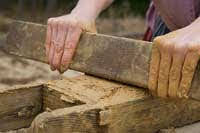Among Mel’s many interests was local history. He researched old maps of the Park area at Chester record office, laboriously scanning some with a line scanner (technology has moved on since!). He found a group of ponds round a hedgerow in the northern half of the Park, marked as ponds on the earliest detailed map he found - Stephenson’s survey for the railway line. At that stage we all presumed that, like most Cheshire ponds, they were old marl pits. Most of the ponds in the group had been destroyed in the making of the railway, mainly the early-1900s widening, or in the house-building, or filled in.
However, as we cleared the top
level of head-high bramble in 1996, Mel found one was still there,
three-quarters full of town ash, but leaving a damp hollow which, the locals
said, had not held water for 70 years. It was full of willow, three-piece
suites and rubbish. We got a grant to hire some help from BTCV (now TCV), and
clearing started.
A large number of heavy,
hand-made bricks were found, including a half-brick with small footprints,
later identified as hedgehog.
 |
| Hedgehog footprints in a hand made brick |
Then a strange metal tool
appeared from the mud.
 |
| Wrought iron tool found at the Butterfly Park |
Mel called in Liverpool Museum, who said “You have an 18th century brickworks!”. New Ferry started as a regular ferry service in 1774, so it is likely the bricks were made for buildings to do with building soon after that. The tool is a rare survivor, blacksmith-made of wrought iron so it had survived 200 years in the mud without rusting away. It would have been used to control and open the field kiln. According to Mel’s researches and the museum, the bricks would have been a side-line of one of the farming families. Clay was dug in autumn, left to weather over winter. We tell the children they would have had to help get stones and roots out of it, and bring it to the men working on a table (a mock-up of a suitable table stands by the brickpit, made by Howard, Ian Jones and “Little Dave” (Dave Holme). The table would have had boxes of water and sand, and wooden moulds.
 |
| Brick mould |
The bricks were moulded and
stacked on layers of twigs to dry. More twigs, more layers of bricks, built on
top, then the lot covered with turves and set on fire. The tool would have been
used to open the kiln at the end by pulling the turves off – hence its long
handle to keep away from the heat.
Brick-making spread through New
Ferry. A large 19th century company was “New Ferry Brick & Tile
Co”, one of whose named bricks we were given and use in talks and walks. The
last brickpit was the hole now housing the Pluto tank and modern sewage works,
clearly visible from Port Sunlight River Park.
Mel then researched and wrote a history of brick-making
in New Ferry, and had started a general history of New Ferry. His papers went
to Bebington Reference library after his death, but we have copies of the
brick-making history and general history.
The brick pit is now a small pond that dries up in dry
periods, but is favoured by small birds to drink when the Park is quiet. We did
an industrial history interpretive board to explain the brick making and
railway, and eventually developed a self-guided industrial history trail
through the whole park (designed by Pete Miller). Guided walks for the Heritage
Open days started 2014 and are done each September.
 |
| The brick pit pond |
Mel’s links to Liverpool Museum led to him persuading them to loan us the Butterfly Case, with examples of all the species recorded from the park (26 different species, about 17-18 breeding each year depending on the Painted Lady migration and whether we have any suitable cabbages for small whites). This has proved invaluable in talking to visitors, and at exhibitions and talks to community organisations. Hilary and Paul each do a few talks annually to local groups, and various volunteers have taken stalls to local events over the years, often jointly with Wirral Wildlife.
 |
| The butterfly case with all butterfly species recorded at the park |

No comments:
Post a Comment